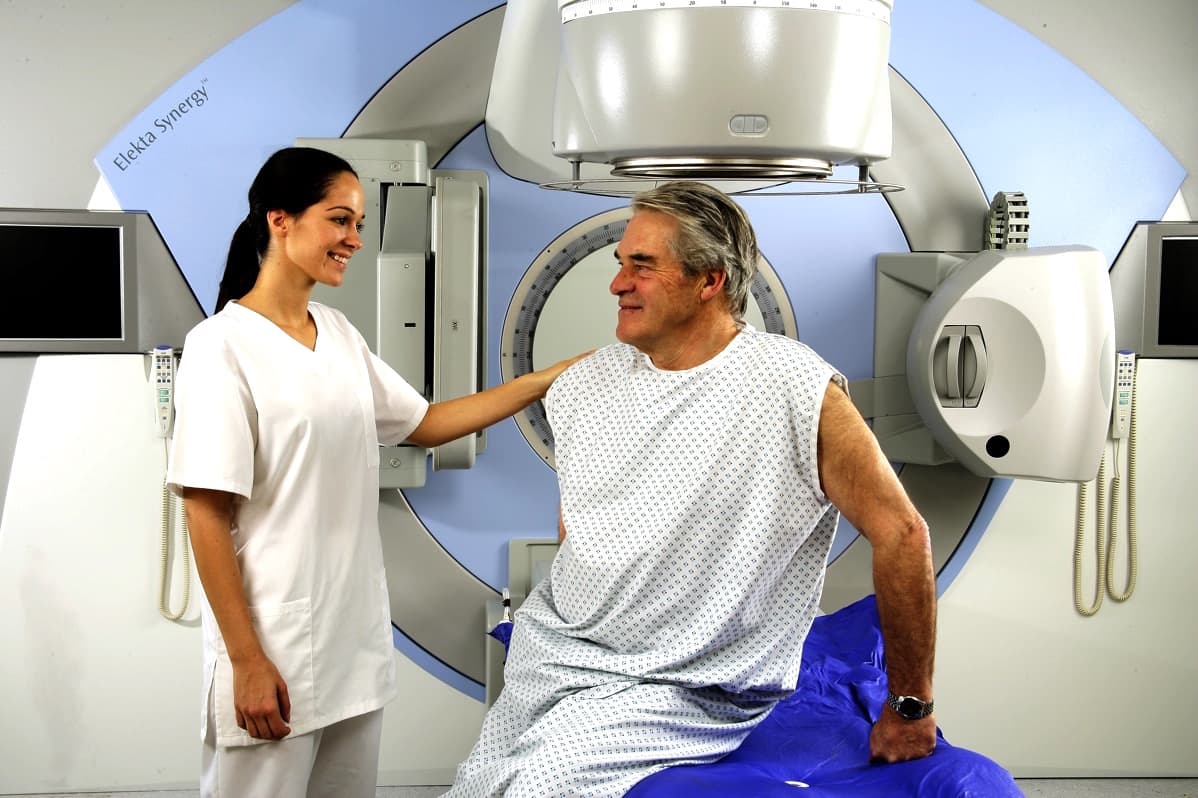Radiation Oncology

Radiation Oncology At Epic Care
Radiation is the art of using therapeutic x-ray and high-energy particles to eradicate tumors and control certain growths. Our radiation oncology treatment is on the cutting edge, utilizing innovations in science and technology to treat your unique cancer.
Our skilled radiation team treats all cancer sites in adults including skin cancer. We also treat some non-cancerous conditions such as keloids, bone/joints before or after orthopedic surgery, non-cancerous brain tumors, non-cancerous skin conditions.
Meet Our Radiation Oncologists
Epic Care is an accredited healthcare facility in Radiation Oncology and Diagnostic Radiology by the American College of Radiology (ACR). Our peers and regulatory organizations have recognized our commitment to cutting edge, patient-centric care with this certification. On top of this, we employ skilled and experienced professionals to deliver your radiation oncology treatment. Our Radiation Oncologists are committed to using cutting edge technology and offering advanced treatments. To learn more about our Radiation Oncologists, read their biographies and radiation specialties here.
Types of Radiation Oncology Treatment at Epic Care
In the East Bay Area, Epic Care offers a number of different types of radiation oncology treatment. We understand that every patient is different and therefore they deserve an individualized radiation plan that is customized to their needs. Whether you are suffering from skin cancer, keloids, or a tumor, we have the radiation treatment for you. Epic Care provides the following types of radiation:
CyberKnife is capable of delivering stereotactic radiosurgery (SRS) treatments, as well as, stereotactic body radiotherapy (SBRT) or stereotactic ablative body radiotherapy (SABR). Unlike traditional stereotactic radiosurgery, CyberKnife is not bound by limited angles of delivery, but rather it is able to deliver treatment from virtually any angle because of its advanced robotic arm.
CyberKnife treatments can be performed in our comfortable outpatient treatment center. In fact, most patients complete their treatment in one to five sessions, which take place over the course of one week. Because of this, patients experience minimal side effects and can generally return to normal activities almost immediately.
Recent advancements in cancer research have led to the development of several types of radiopharmaceuticals that target and destroy cancer at the cellular level. At Epic Care we offer radiopharmaceutical treatment options for patients with advanced prostate cancer and/or neuroendocrine tumors. To learn more, click here.
Managing pain and other symptoms caused by chronic musculoskeletal conditions can be challenging. At Epic Care, we’re proud to offer low-dose radiation therapy (LD-RT) as an alternative treatment when other pain management options have not been effective—all conveniently close to home. To learn more, click here.
If you have a brain tumor that is being removed with surgery, you will likely need radiation therapy after surgery. Radiation therapy uses high-energy x-rays to damage the DNA of cells. This helps kill any cancer cells that may be left after surgery. With traditional radiation therapy, you receive treatment 5 days a week for many weeks. GammaTile is a different type of radiation used for treating brain tumors. The goal of GammaTile Therapy is to stop brain tumors from coming back after surgery. To learn more, click here.
We use image guided radiation therapy (IGRT), one of the most cutting-edge innovations in cancer technology available. Tumors can move, because of breathing and other movement in the body. IGRT allows our doctors to locate and track the tumor at the time of treatment. With this technology, we can deliver precise radiation treatment to tumors that shift as a result of breathing and movement of the bladder and bowels.This also allows our radiation oncologists to make technical adjustments when a tumor moves outside of the planned treatment range. As a result, the radiation treatment is targeted to the tumor as much as possible, helping to limit radiation exposure to healthy tissue and reduce common radiation side effects.
IMRT uses advanced software to plan a precise dose of radiation, based on tumor size, shape and location. A computer-controlled device called a linear accelerator delivers radiation in sculpted doses that match the exact 3D geometrical shape of the tumor, including concave and complex shapes.
With IMRT, our radiation oncologist can adjust the intensity of radiation beams across the treatment area as needed with laser accuracy. This means we can deliver higher radiation doses than traditional radiation therapy methods, while minimizing exposure to healthy tissues.
Because of its greater degree of accuracy, IMRT may be a treatment option for patients who have reached the maximum allowable dose of conventional radiation therapy and have a recurrent tumor in the treated area.
VMAT is a cutting edge advancement which allows our radiation oncologists to deliver Intensity-modulated radiation therapy (IMRT) in a much more efficient way. Rather than using several different beams to treat your tumor, VMAT can perform the entire treatment in one or two arcs. This can improve treatment speed by as much as three-fold which will reduce the time that you spend each day in treatment.
Metabolically guided radiation therapy incorporates information from Positron Emission Tomography (PET) imaging (a metabolic method of tumor imaging) into the standard radiation treatment plan. It fuses CT and Positron Emission Tomography (PET) data to help identify tumor targets – particularly for lung, esophageal and hematological malignancies – with greater precision. In essence, this technology allows our radiation oncologists to precisely target fast-growing tumors (high metabolism) while sparing surrounding normal tissue.
During treatment, patients can lose weight or experience swelling. These changes in your body can sometimes make high-precision treatment less accurate. To prevent this, our practice utilized adaptive radiation therapy to monitor these changes and intelligently modify your treatment plan so that it remains precise and accurate.
Stereotactic radiosurgery uses high-energy x-ray beams to deliver large doses to small tumors over a short period of time (one to five treatments). This procedure is highly accurate and is planned in conjunction with our community surgeons. To ensure the ultimate in treatment accuracy we use a stereotactic system, which localizes the target in three-dimensional space using a personalized grid. SRS/SRT can be used to treat localized tumors in virtually any part of the body. At Epic Care we offer brain, lung, bone, liver SRS/SRT.
These radioactive sources emit internal radiation at a fast rate, so they can deliver a higher dose in a shorter amount of time. Thus the sources generally never stay in the body permanently. Instead, they dwell in a tumor temporarily, usually less than 10 minutes at a time. Patients will need repeated sessions, ranging from 3 to 10, depending on the type of cancer. The HDR source is housed in a little robot called a remote afterloader. During each treatment session, the source is precisely placed into the target area by this computer-controlled robot. The use of HDR sources is the most proven and reliable brachytherapy treatment for breast (accelerated partial breast irradiation), skin, gynecological, and certain prostate malignancies. It can also be used for many other cancers, including head and neck, esophagus, sarcoma, and lung. Epic Care is the first center in Contra Costa County to offer HDR brachytherapy. Our board-certified specialists are trained at one of the most renowned brachytherapy centers in the United States.
When Active Breathing Coordinator is used during radiation therapy, the patient takes a deep breath before the beam of radiation is delivered. This deep breath increases the distance between the area receiving radiation (the breast tissue or chest wall on the patient’s left side) and the heart. Increasing this distance means there is less risk the heart will receive any incidental radiation during treatment and, therefore, there is less risk of the patient developing radiation-induced heart disease.
Intra-operative radiation therapy (IORT) is the use of radiation therapy in the operating room during a surgical procedure. To learn more, click here.
Each year, more than 60,000 men opt for radiation therapy to treat prostate cancer. Radiation aims to kill cancer cells while avoiding damage to surrounding healthy tissue. However, radiation can cause damage to the rectum due to its proximity to the prostate, potentially creating issues with urinary, sexual and bowel functions.
SpaceOAR™ Hydrogel is an absorbable hydrogel that temporarily creates space between the prostate and rectum, designed to reduce radiation dose to the rectum to help minimize the side effects of radiation therapy. To learn more, click here.
If you are interested in a specific type of radiation oncology treatment, please consult our radiation team.
Contact Epic Care for Radiation Oncology in the East Bay!
If you are looking for a skilled radiation oncologist who can develop a treatment plan specific to your case and needs, contact Epic Care in the East Bay Area. Our team of highly skilled healthcare professionals and physicians will be happy to discuss our treatment options with you and find the most appropriate radiation treatment for you. Find a doctor near you today! We look forward to helping you and restoring your health.








